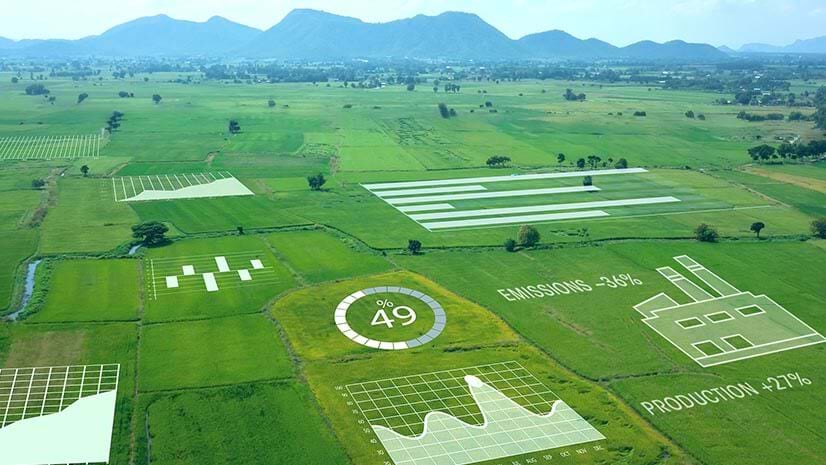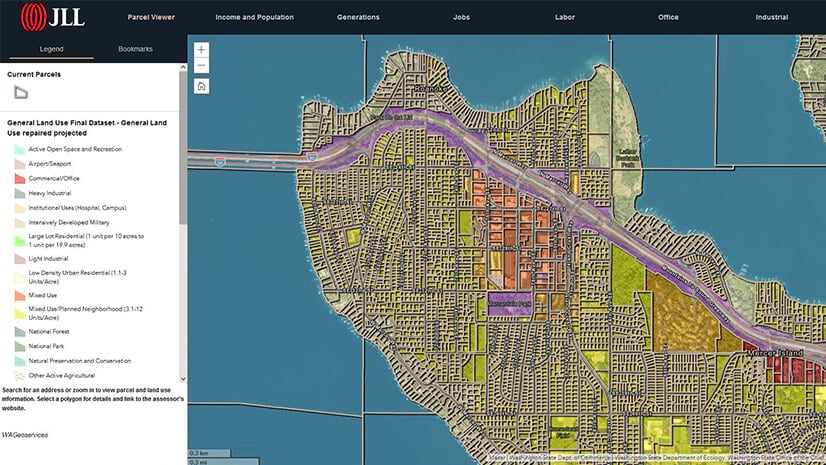As close collaborators with many commercial companies, Brian Cross and Kevin Bolger enjoy a unique view of the ways in which Internet of Things (IoT) technology and big data are creating business advantage. After many years of partnering with companies on the cusp of the IoT journey, both have learned the best ways for companies to get started.
In this inaugural conversation in WhereNext’s Think Tank series, Cross, who runs Esri’s Professional Services group, talks with Bolger, a senior consultant in the organization. Topics include:
- Areas where the IoT and big data are producing business benefits already
- The value of integrating public and private data
- Missteps on the path to IoT success
- The location data that pioneering companies use to their advantage
Brian Cross: We hear a lot of buzz around the Internet of Things, or IoT, and big data. What do they mean to you?
Kevin Bolger: These days, a lot of people associate the Internet of Things with live data, while they associate big data with historical analysis—the back-end stuff. To me, these are two parts of the same thing. It all boils down to data.
The IoT portion is really about being able to capture data with sensors, cars, mobile devices, and other assets—even people [see sidebar]. Then big data takes that and processes it, whether in real time, in batches, or anything else. The important part is the ability to get value out of this data by doing analytics. And location plays a huge part of that. Being able to tie all that information to where things are happening and how things are happening is a big component.
IoT and Big Data in Action
Cross: I know there’s some hype surrounding these terms. But people are making great strides in solving real problems today. Can you share some examples of that?
Bolger: One multibillion-dollar agricultural producer we work with makes good use of the Internet of Things. Because its products need to go from a farm all the way to a retail location in a limited period of time, the company tracks information about the product as it moves from the field to a processing center, a distribution center, and then a retail location. The company is using that information to understand not only where the product went in the supply chain and how long it took to get there but to analyze, for instance, an exceptional batch of produce. They can see where that batch came from—even what part of a field it came from. Then they can look at how they treated that field differently. So the company is doing analytics on the back end to help improve the product that they deliver to their customers.
We tend to think of the Internet of Things as a network of sensors, but you can also think of it as the bar code on the clamshell package that holds the produce. That creates visibility not just of a shipment but down to an individual SKU. So IoT data can give a company fine-grain tracking and understanding of its assets. That also pays dividends when it comes to reverse logistics. If specific products need to be recalled, a company that knows the product’s origins down to the SKU level can perform more selective recalls and avoid waste.
In the automotive industry, a lot of people are speculating about when we’ll all have fully autonomous cars. But IoT and big data are playing a huge role today, because automakers are collecting information from cars that we’re driving, and they’re using that to make better decisions about how to design vehicles, how their customers use vehicles, and new services they can provide to those customers.
[Explore this e-book for a deeper look at how businesses are harnessing IoT data.]
Analysis across Industry Lines
Cross: I couldn’t help but notice another use of IoT in the public sector recently. Obviously, Hurricanes Harvey and Irma were devastating and hard to watch. But maybe one of the learnings was how we saw the technologies underlying these trends play a meaningful role in the response effort.

We often think about location as the ultimate integrating factor for IoT data.
For example, the National Water Center had done a big data analytics model over the six months before the storm to gauge streamflow across the entire continental US stream network. As a result, for the first time ever, they could model and predict the flow through the whole cycle.
When Harvey hit, various organizations used GIS [geographic information system technology] to combine that macro model with live IoT data from stream gauges in Houston and—in real time—do large data computation to predict the next day’s flood impact. With that analysis, relief organizations knew where to put shelters and who needed to be moved before the floods arrived.
That was an example—in addition to what you talked about in the commercial space—of IoT, big data, predictive analytics, and computation at scale happening in real time to solve real problems. It is really powerful to think about what can happen today.
Bolger: That’s an important example, and I think we can bring it back into the commercial sector as well. Insurance companies, for example, need to understand very similar things in disaster areas. Where are the storm impacts happening? Where are floods occurring? Where do I have either insurance policies or employees, and what is my exposure in these areas?
Insurance companies need to make sure they’re getting to the people who need the most help, as soon as possible. So these companies are taking in and analyzing all this data from weather services and risk management applications. And they’re out there collecting information, too.
They’re doing that through IoT devices like phones and tablets. An insurance adjuster who is going out to help someone is also taking pictures and collecting data on the way—on flooding and fire damage, for example, or road conditions. Adjusters that are armed with this information and an analysis of the damaged areas know where they need to focus their attention. Insurance companies can tap the same information to calculate their exposure during and after an event.
Public versus Private IoT
Cross: One thing that you just touched on is important to dissect. There are IoT sensors and devices that are public domain, and IoT sensors and methods that are private. Insurance companies, for one, are getting much smarter about how to use public domain IoT sensors that have been location enabled and are available as web services. During events like Harvey, some of those companies connect to the same public sensors that FEMA [Federal Emergency Management Agency] and other agencies use to do their business calculations.
Bolger: In the case of Harvey, the public IoT sources were stream gauges, flow networks, the modeling around stream rise, and others. The private IoT sources included the insurance companies’ client lists, the information coming in from phone calls, and their own assessments—even footage from their own drones.
That just shows you the proliferation of location-aware IoT data. We’ve got this ecosystem now of people, organizations, and businesses, both private and public, that are creating and sharing information. Organizations are leveraging that across multiple business functions to provide the right services, the right decisions, and the right value.
And there’s another piece of IoT that we can’t forget about, and that’s social media. A lot of organizations these days are using channels like Twitter and Facebook to improve situational awareness.
Cross: So even though it’s not authoritative content like a government sensor on stream depth, that crowdsourced information is important to businesses.
Bolger: Exactly. Waze is a great example. We’re using people to tell us what’s going on in the roads—things like traffic, accidents, or construction—and all these things are being shared.
Cross: And Waze is a good example of public-private collaboration on IoT data. Waze has this great data from all the people using the app. They’re now providing that as a location-based web service to cities, in exchange for the cities’ providing a web service on planned street closures. One is private IoT data, and one is public, and there’s a give/get that works for everybody here.
Supply Chain: Beyond Track and Trace
Cross: Let’s talk about the supply chain for a minute. How are IoT, big data, and predictive analytics being put to work there?
Bolger: The agricultural producer I mentioned—they’re adding IoT data to go beyond basic supply chain visibility. We’re also seeing IoT, big data, and predictive analytics put to use by manufacturers.
There are two sides to that: the proactive side and reactive side. Proactively, manufacturers want to understand where risk is. As they build out their facilities and their suppliers, they want to use the information they can capture to understand risks in that supply chain and build a resilient network so they can minimize failures.

Three key players guide a company's IoT efforts: the business owner, the IT experts, and the SMEs who know how to use location intelligence and GIS technology. A corporate sponsor would be the fourth.
On the reactive side, it’s all about information again: being able to understand the impact of events where they’re happening, how they’re happening, and which customers might be affected.
If we return to the example of hurricanes, organizations that have suppliers or businesses need to understand which of them might be impacted. For example, it’s a fairly well-known statistic that shutting down an assembly line in an automotive company can cost over $1 million an hour in lost revenue. So they want to know as soon as possible if there’s a problem so they have more time to react and avoid shutting down that line.
Cross: What’s impressive is the level of detail companies are getting from IoT data. They can see exactly which parts won’t get through the Houston terminal over the next two weeks, for example. And once they know that exactly 27 speed sensors are at risk, they might enlist a local supplier to spin up production.
What Are the Business Benefits?
Cross: Using IoT data to avoid a $1 million-per-hour shutdown is a straightforward ROI calculation, but in many cases, the calculation is more oblique. What kinds of business benefits are companies getting from IoT and big data?
Bolger: The technology and techniques are still relatively new, but we’re definitely seeing business impacts. In the case of the agricultural company we discussed, they’re not only putting better products in stores; they’re also making the whole supply chain process more efficient. Each box of produce is scanned at every stop of the journey from field to store. That allows the company to analyze the distribution process and remove roadblocks. Because produce is perishable, time really is money. So that’s adding to their bottom line as well.
Trucking and logistics companies are using IoT to track packages and make sure deliveries reach customers on time. They’re also using tracking data to make their operations more efficient: to save gas, reduce mileage, ensure that their drivers don’t exceed their allotted hours for the day, and more. That helps improve the bottom line.
Retail companies, as another example, are analyzing patterns of life through data that’s collected from the apps people opt in to on their mobile devices. Retailers are able to understand not just buying behaviors but travel patterns and where people shop. That location analysis helps them decide where to place their stores, where to advertise, and how to market to potential customers more effectively. That, in turn, increases in-store traffic and improves sales.
IoT-based data is enabling all these business outcomes, and location is a key component that pulls all the data together.
How to Get Started
Cross: One of the most important questions for someone reading this is, What do I need to be thinking about if I want to enter into this world of big data, IoT, and location analytics?
Bolger: I think the key component here is identifying and defining a real business problem, something that is important for the business to solve. Once that is defined, then the business can leverage the data it’s connecting to and apply location analytics to the challenge. That helps provide the answers needed to make business decisions.
Cross: You’re absolutely right. One of the methods to making this successful that we’ve seen over and over again is defining a business problem and then finding a quick win in that space, getting a tangible result quickly that proves that you can do it, has a business bottom line or mission outcome that’s critical, and also enables the rest of the organization to see this is a worthwhile investment of time and money.
We see that in every aspect of location strategy but particularly in emerging areas like IoT and big data. Get a quick win that solves a real problem right away and then iterate from there.
Listen to this podcast for more on the role of IoT in digital transformation.











